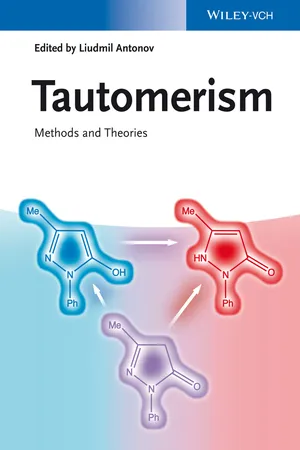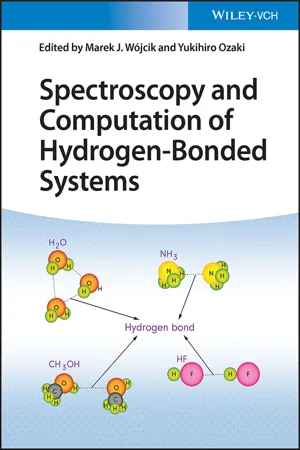Chemistry
Tautomerism
Tautomerism is a chemical phenomenon where a molecule can exist in two or more forms that differ in the position of a proton or a double bond. These forms are called tautomers and can interconvert rapidly. Tautomerism is important in biochemistry and organic chemistry.
Written by Perlego with AI-assistance
Related key terms
Related key terms
1 of 4
Related key terms
1 of 3
4 Key excerpts on "Tautomerism"
- eBook - ePub
Tautomerism
Methods and Theories
- Liudmil Antonov(Author)
- 2013(Publication Date)
- Wiley-VCH(Publisher)
Chapter 1 Tautomerism: Introduction, History, and Recent Developments in Experimental and Theoretical Methods Peter J. Taylor, Gert van der Zwan, and Liudmil Antonov 1.1 The Definition and Scope of Tautomerism: Principles and Practicalities Prototropic Tautomerism, defined by one of its early investigators as “the addition of a proton at one molecular site and its removal from another” [1], and hence clearly distinguished from ionization, is one of the most important phenomena in organic chemistry despite the relatively small proportion of molecules in which it can occur. There are several reasons for this. Enantiomers, or cis and trans isomers, possess a formulaic identity just as tautomers do but are difficult to interconvert and hence easy to isolate. Tautomers are different. Tautomers are the chameleons of chemistry, capable of changing by a simple change of phase from an apparently established structure to another (not perhaps until then suspected), and then back again when the original conditions are restored, and of doing this in an instant: intriguing, disconcerting, perhaps at times exasperating. And a change in structure means changes in properties also. A base may be replaced by an acid and vice versa, or more to the point perhaps, a proton acceptor group by a proton donor, as, for instance, carbonyl by hydroxyl. Hence, if the major tautomer has biological activity, the replacement of this structure by another may result in a total mismatch in terms of receptor binding or the partition coefficient. It therefore becomes vital, on the most elementary level, to know which tautomer is the major one, since not only the structure but also the chemical properties are bound up with this. This problem is compounded by another: there is no automatic guarantee that, if the great majority of known compounds in a given category exist chiefly as one tautomer, the next one to be investigated will follow their lead. Examples of this sort will be described below - eBook - ePub
- Marc Descamps(Author)
- 2016(Publication Date)
- Wiley-VCH(Publisher)
Chapter 7 Tautomerism in Drug DeliveryZaneta Wojnarowska and Marian PaluchAccording to common knowledge, Tautomerism is observed when one chemical compound is represented by two or more molecular structures that are related by an intramolecular movement of hydrogen between different polar atoms and the rearrangement of double bonds [1]. The most commonly observed examples of this phenomenon are reversible transformations between ketone and enol, amide and imidic acid, lactam and lactim, or enamine and imine forms. On the other hand, the tautomeric reactions in which the heterocyclic ring is opened and closed is usually called ring–chain Tautomerism or mutarotation in the case of carbohydrates chemistry.Tautomerization attracts the attention of scientists from many disciplines, including physics, organic and biochemistry, and pharmaceutical science. It is of great importance especially in drug industry because there are a number of active pharmaceutical ingredients (APIs), biopharmaceuticals, and chemical excipients (e.g., saccharides) that readily convert into other isomers when their crystalline structure is lost. According to the literature data, 26% of commercially available APIs reveal the ability to exist in more than one chemical form (Figure 7.1 ) [2].Adapted from Martin [2]. Reproduced with permission of Springer.Frequency distribution of tautomers of a marketed drug.Figure 7.1 - Marek J. Wójcik, Yukihiro Ozaki(Authors)
- 2022(Publication Date)
- Wiley-VCH(Publisher)
Tautomerism is important in biological systems. o ‐hydroxy Schiff bases have been investigated in great detail. Limbach et al. [ 103 ] used N ‐(3,5‐dibromosalicylidene)‐methylamine and similar Schiff bases as models in the study of transamination instead of pyridoxal‐5′‐phosphate. This was recently discussed in [ 104 ]. Tautomerism was also studied in N ‐(pyridoxylidene)‐methylamine. In this case, a deuterium isotope effect at N2 (Schiff base nitrogen) of −3.09* ppm and in the 1 : 1 complex with trifluoroacetic acid an effect of 3.54* ppm. This was interpreted as deuterium being primarily at oxygen in the former case and primarily on nitrogen in the latter [ 105 ]. Tautomerism is also observed as Schiff base with a carboxylic acid ortho to the OH group, which enables different hydrogen bond patterns (see Figure 7.26) [ 106 ]. Tautomerism of Schiff bases modified with amino acid ionic liquid structure [ 107 ] or amino acids [ 108, 109 ] can be monitored based on deuterium isotope effects at C‐2 (Figure 7.27). The hydrogen bond with the acid group clearly influences the equilibrium but also from the OH group of threonine. Figure 7.26 Schiff bases with a carboxylic acid group in ortho position. Figure 7.27 Example of a Schiff base modified to contain an amino acid. Figure 7.28 Tautomerism of piroxicam. Piroxicam (see Figure 7.28) is an NSAID drug. Deuteration studies showed proportionality between isotope effects on 13 C chemical shifts and chemical shift differences except for the carbons close to the site of protonation (C‐7, C‐9, C‐11, and C‐12). See discussion about equilibrium isotope effects (Section 7.14) [ 110 ]. Interestingly, the zwitterionic structure is the result of a reorientation and formation of new hydrogen bonded structures. Isotope effects have also been used to show that a compound (1,1′,1″‐(2,4,6‐trihydroxybenzene‐1,3,5‐triyl) triethanone) was not tautomeric [ 111 ] although Tautomerism had been claimed [ 112 ]- eBook - ePub
Carbohydrate Chemistry
Fundamentals and Applications
- Raimo Alén(Author)
- 2018(Publication Date)
- WSPC(Publisher)
Fig. 3.1. The main types of isomerism and their subtypes.The branch of organic chemistry that examines the three-dimensional structures of molecules,stereochemistry, has gained importance when striving to understand the physical and chemical properties of various compounds. In carbohydrate chemistry, it is also essential to know the stereochemical structure of the compounds. Stereoisomerism can be seen to generally represent the form of isomerism where compounds with the same chemical structure (i.e., the order of attachment of the atoms involved and the location of the bonds between them) differ from each other only in the spatial direction of their atoms or atom groups. This isomerism is divided into (i)optical isomerism(“physical isomerism”), (ii)conformational isomerism, and (iii)geometric isomerism(“cis/transisomerism”). As the first two types are characteristic of carbohydrates, they will be emphasized in the following discussion.3.2.Constitutional Isomerism
Constitutional isomers generally differ from one another only in the order of attachment of their atoms and the location of their bonds. In the functional group isomerism, the isomers have the same molecular formula, but their functional groups are different. The following compounds are examples of such isomers:Chain isomers have the same molecular formula, but the skeleton (usually carbon skeleton) differs by having branches or otherwise. The following compounds (C5 H12 ) are examples:The number of chain isomers increases very rapidly with the increase in the number of carbon atoms in the compound. Theoretically, for 6, 7, 8, 15, and 20 carbon atoms in an aliphatic hydrocarbon, the numbers of possible chain isomers are 5, 9, 18, 4347, and 366,319, respectively.
Index pages curate the most relevant extracts from our library of academic textbooks. They’ve been created using an in-house natural language model (NLM), each adding context and meaning to key research topics.
Explore more topic indexes
Explore more topic indexes
1 of 6
Explore more topic indexes
1 of 4



